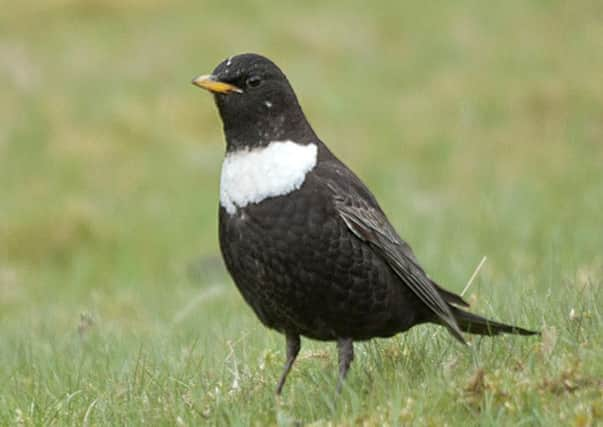Birdwatch: Silvery migrants undercover amid the blackbirds


They have been reported on gorsy hillsides, in horse paddocks and the occasional suburban garden while others on the way back to Scandinavia have been seen on the east coast.
It is certainly worth taking a closer look at any blackbirds just now to see if a ring ouzel might be among them. At first glance the species look very like but the ring ouzel has a white crescent just below the throat, also silvery patches on the wings. The plumage has a silvery sheen because of the thin white edges to the feathers.
Advertisement
Hide AdAdvertisement
Hide AdRing ouzels head for high ground in the Pennines, north west England and Scotland choosing open stretches of moorland with a few rocks or isolated trees that the males can use as song posts. They also need sheltered gullies to nest in.
The species has declined sharply in many places and the high mortality rate of the young is thought to be a major cause.
Researchers found that eggs laid by modern ring ouzels have much thinner shells than those in museum collections that were laid in Victorian times, a trend believed to be the result of acid rain caused by pollution from coal fired power stations which reduces calcium levels in the worms and other invertebrates that ring ouzels eat.
Other returning migrants have included the first common redstarts at the RSPB’s Adwick Washlands reserve in the Dearne Valley, Wrenthorpe, West Yorkshire; two at Potteric Carr; a whitethroat at Wintersett, South Yorkshire, and the first pied flycatchers, sedge and grasshopper warblers.
Advertisement
Hide AdAdvertisement
Hide AdHobbies were seen over Hatfield Moors, South Yorkshire and Fairburn Ings near Castleford. There were also more wheatears, house martins, swallows, willow warblers and white and yellow wagtails.
Overshooting spring migrants from Europe included an Alpine swift seen at several places last Saturday along the cliffs at Flamborough Head, a serin seen at Spurn and a bee-eater at Rother Valley Country Park, South Yorkshire.
Arctic terns were spotted on passage in several places, common terns started to be seen back on inland waters where they will breed and a Sandwich tern was seen inland at Orgreave lagoons, South Yorkshire.
Four little gulls were seen at Angler’s Country Park near Wakefield.
Advertisement
Hide AdAdvertisement
Hide AdAlso well inland, were three long-tailed ducks at Skelton Lake, Leeds, first seen last Friday and still present this week while common scoters were at Swillington Ings and at Nosterfield Quarry, North Yorkshire.
A great grey shrike continued to be seen at Midhope Moor, South Yorkshire while another was discovered at Dean Head reservoir, Scammonden, West Yorkshire.
Black-necked grebes were being spotted too, at Hatfield Moors and Tophill Low, East Yorkshire.